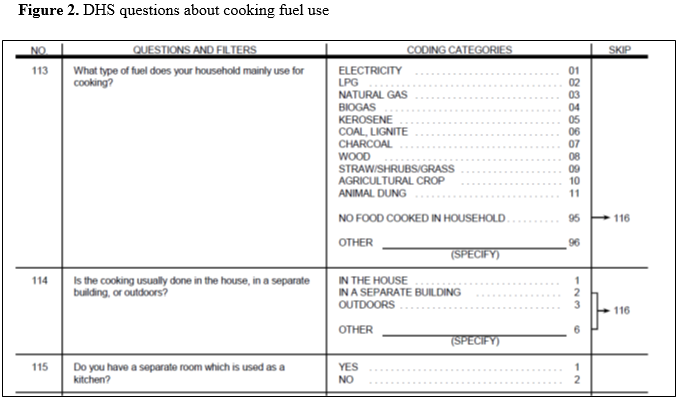You are here
Percent of Household Fuel by Type (and Source)
More detailed questions are needed to understand shifts in household fuel consumption amounts and the sources of those fuels. Brocard et al. (1998) summarize the literature on wood and charcoal consumption for West Africa. On average, fuelwood consumption per capita is 1.3kg wood per day and 4g charcoal per day (Brocard et al., 1998). Another study points out that consumption depends on household size, with larger households having lower per capita fuel consumption due to shared cooking (Cline-Cole et al., 1990).
How to operationalize the metric
Method of data collection and data needed to compute the method:
Many household surveys and censuses ask questions about the solid fuels used by households (e.g., wood, crop residues, dung, charcoal, coal) because of the concern about indoor air pollution from cooking on solid fuels (Bonjour et al. 2013). The Demographic and Health Survey (USAID, 2015) contains three questions related to cooking but does not attempt to quantify how much fuel is used.
Source: USAID, 2015, available from http://dhsprogram.com/publications/publication-dhsq7-dhs-questionnaires-and-manuals.cfm
In a study to assess how pigeonpea and fuel-efficient stoves affected deforestation, Orr et al. (2015) asked households to estimate the number of times per month they collected fuelwood, the number of family members who participated in collecting fuelwood (to estimate the number of bundles collected each month), and the number of bundles bought each month. The researchers then estimated average weights for head loads (33kg) and for bundles sold in the local market (9.4kg). They note that their questions may not include fuelwood collected from farmers’ own trees or woodlots (Orr et al., 2015).
Another study in Malawi explored how wood collection shifted as availability decreased (Brouwer et al., 1997), pointing out how labor availability influences fuel type collected, with smaller households using closer sources of lower quality. Researchers asked each household the type of fuels they used, how they used each fuel (i.e., cooking, space heating, heating bath water, sales), and how much of each type they had in stock. They also asked about fuel purchase and collection (i.e., place, distance, frequency, time required, amount, household member responsible for each). Headloads were converted to kg by directly measuring the most recent headload size. Data was collected during the dry season, the rainy season, and the harvest season (Brouwer et al. 1997).
In Burkina Faso where fuelwood is transported by cart (charet), the volume of wood can be estimated at 3m3/charet and then monthly consumption per household can be obtained by asking how many carts were collected in a month (Etongo et al., 2016). These researchers also asked about how much was sold and where the wood was collected.
Unit of analysis:
Content here
Limitations regarding estimating and interpreting:
Content here

